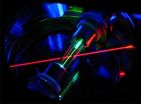(Press-News.org) A clock accurate to within a tenth of a second over 14 billion years – the age of the universe – is the goal of research being reported this week by scientists from three different institutions. To be published in the journal Physical Review Letters, the research provides the blueprint for a nuclear clock that would get its extreme accuracy from the nucleus of a single thorium ion.
Such a clock could be useful for certain forms of secure communication – and perhaps of greater interest – for studying the fundamental theories of physics. A nuclear clock could be as much as one hundred times more accurate than current atomic clocks, which now serve as the basis for the global positioning system (GPS) and a broad range of important measurements.
"If you give people a better clock, they will use it," said Alex Kuzmich, a professor in the School of Physics at the Georgia Institute of Technology and one of the paper's co-authors. "For most applications, the atomic clocks we have are precise enough. But there are other applications where having a better clock would provide a real advantage."
Beyond the Georgia Tech physicists, scientists in the School of Physics at the University of New South Wales in Australia and at the Department of Physics at the University of Nevada also contributed to the study. The research has been supported by the Office of Naval Research, the National Science Foundation and the Gordon Godfrey fellowship.
Early clocks used a swinging pendulum to provide the oscillations needed to track time. In modern clocks, quartz crystals provide high-frequency oscillations that act like a tuning fork, replacing the old-fashioned pendulum. Atomic clocks derive their accuracy from laser-induced oscillations of electrons in atoms. However, these electrons can be affected by magnetic and electrical fields, allowing atomic clocks to drift ever so slightly – about four seconds in the lifetime of the universe.
Because neutrons are much heavier than electrons and densely packed in the atomic nucleus, they are less susceptible to these perturbations than the electrons. A nuclear clock should therefore be less affected by environmental factors than its atomic cousin.
"In our paper, we show that by using lasers to orient the electrons in a very specific way, we can use the neutron of an atomic nucleus as the clock pendulum," said Corey Campbell, a research scientist in the Kuzmich laboratory and the paper's first author. "Because the neutron is held so tightly to the nucleus, its oscillation rate is almost completely unaffected by any external perturbations."
To create the oscillations, the researchers plan to use a laser operating at petahertz frequencies -- 10 (15) oscillations per second -- to boost the nucleus of a thorium 229 ion into a higher energy state. Tuning a laser to create these higher energy states would allow scientists to set its frequency very precisely, and that frequency would be used to keep time instead of the tick of a clock or the swing of a pendulum.
The nuclear clock ion will need to be maintained at a very low temperature – tens of microkelvins – to keep it still. To produce and maintain such temperatures, physicists normally use laser cooling. But for this system, that would pose a problem because laser light is also used to create the timekeeping oscillations.
To solve that problem, the researchers include a single thorium 232 ion with the thorium 229 ion that will be used for time-keeping. The heavier ion is affected by a different wavelength than the thorium 229. The researchers then cooled the heavier ion, which also lowered the temperature of the clock ion without affecting the oscillations.
"The cooling ion acts as a refrigerator, keeping the clock ion very still," said Alexander Radnaev, a graduate research assistant in the Kuzmich lab. "This is necessary to interrogate this clock ion for very long and to make a very accurate clock that will provide the next level of performance."
Calculations suggest that a nuclear clock could be accurate to 10 (-19), compared to 10 (-17) for the best atomic clock.
Because they operate in slightly different ways, atomic clocks and nuclear clocks could one day be used together to examine differences in physical constants. "Some laws of physics may not be constant in time," Kuzmich said. "Developing better clocks is a good way to study this."
Though the research team believes it has now demonstrated the potential to make a nuclear clock – which was first proposed in 2003 – it will still be a while before they can produce a working one.
The major challenge ahead is that the exact frequency of the laser emissions needed to excite the thorium nucleus hasn't yet been determined, despite the efforts of many different research groups.
"People have been looking for this for 30 years," Campbell said. "It's worse than looking for a needle in a haystack. It's more like looking for a needle in a million haystacks."
But Kuzmich believes that that problem will be solved, allowing physicists to move to the next-generation of phenomenally accurate timekeepers.
"Our research shows that building a nuclear clock in this way is both worthwhile and feasible," Kuzmich said. "We now have the tools and plans needed to move forward in realizing this system."
INFORMATION:
Researchers develop blueprint for nuclear clock accurate over billions of years
2012-03-20
ELSE PRESS RELEASES FROM THIS DATE:
Soy-based S-equol supplement reduces metabolic syndrome risk factors
2012-03-20
Washington, DC. (March 19, 2012) – A 12-week treatment of the fermented soy germ-based nutritional supplement containing S-equol significantly lowered hemoglobin A1c (HbA1c), LDL cholesterol and improved vascular stiffness, all factors that occur as part of metabolic syndrome, according to a first-of-its-kind peer-reviewed study reported in a poster at the Women's Health 2012 annual meeting.
"This study is the first to provide evidence that a daily supplement of soy-based S-equol favorably change metabolic syndrome risk factors, particularly in women. Because not all ...
Study: Including ads in mobile apps poses privacy, security risks
2012-03-20
Researchers from North Carolina State University have found that including ads in mobile applications (apps) poses privacy and security risks. In a recent study of 100,000 apps in the official Google Play market, researchers noticed that more than half contained so-called ad libraries. And 297 of the apps included aggressive ad libraries that were enabled to download and run code from remote servers – which raises significant privacy and security concerns.
"Running code downloaded from the Internet is problematic because the code could be anything," says Dr. Xuxian Jiang, ...
Kloverpoint Integrates Twitter with its Content Publishing and Social Collaboration Services
2012-03-20
Kloverpoint Technologies Inc. is pleased to announce the release of its newest tool that will allow its network members to quickly post updates and announcements to Twitter regarding new content created and published on Kloverpoint.
Creating and sharing webpages and photo albums are some of the main features of Kloverpoint. The integration of Twitter with Kloverpoint allows for quick announcement postings that will notify Twitter followers that new content is available on Kloverpoint.
"With the release of our newest tool, Kloverpoint users will not need to ...
Targeted X-ray treatment of mice prevents glaucoma
2012-03-20
Jackson Laboratory researchers have demonstrated that a single, targeted x-ray treatment of an individual eye in young, glaucoma-prone mice provided that eye with apparently life-long and typically complete protection from glaucoma.
In research published March 19 in the Journal of Clinical Investigation, Gareth Howell, Ph.D., Simon John, Ph.D., (professor and Howard Hughes Medical Investigator) and colleagues also used sophisticated genomics methods to uncover some of the very first pathways to change during glaucoma in these mice. The first pathway they detected to change ...
To combat identity theft, protect computer
2012-03-20
EAST LANSING, Mich. — Having a triple-threat combination of protective software on your computer greatly reduces your chances of identity theft, according to a study led by a Michigan State University criminologist.
In a survey of more than 600 people, the researchers found that computer users who were running antivirus, anti-adware and anti-spyware software were 50 percent less likely to have their credit card information stolen.
The study appears in the research journal Deviant Behavior.
"When you think about antivirus software protecting you, you might think about ...
Curtains Up On New US Marketing Business billWheels.com
2012-03-20
Monday, March 19, 2012 marked billWheels.com's entrance into the fierce and competitive world of marketing firms. The company's founder, Scott Anderson, states that he plans to help SUV owners with gas purchases, loan payments, or other costs involved to use their own vehicles by helping them leverage very simple, very effective advertising space that already sits on the back of their vehicles -- their spare wheel tire covers.
"There is nothing more powerful than an idea that's overdue to be in existence," says Scott. Driving home from his 7-4 job, the idea ...
Microbiologists can now measure extremely slow life
2012-03-20
"Mud samples boiled in acid sounds like witchcraft," admits microbiologist Bente Lomstein from the Department of Bioscience when explaining how she and an international group of researchers achieved the outstanding results being published today in the journal Nature.
Bacteria are the only living organisms to produce D-amino acids that deposit a chemical signature in the mud in which they live. Researchers at the Department of Bioscience and the Danish National Research Foundation's Center for Geomicrobiology at Aarhus University have used this knowledge together with American ...
Infection prevention groups outline steps needed to preserve antibiotics
2012-03-20
Washington, March 19, 2012 – Infection preventionists and healthcare epidemiologists play key roles in promoting effective antimicrobial stewardship in collaboration with other health professionals, according to a joint position paper published today by the Association for Professionals in Infection Control and Epidemiology (APIC) and the Society for Healthcare Epidemiology of America (SHEA) in their respective peer-review journals, the American Journal of Infection Control and Infection Control and Hospital Epidemiology.
Antimicrobial agents, which include antibiotics ...
UNH researcher: Gulf, Balkan wars add new dimensions to war trauma
2012-03-20
DURHAM, N.H. – A new book by a University of New Hampshire researcher and Vietnam-era disabled veteran sheds new light on the long-term psychological trauma experienced by the coalition force in recent wars in the Gulf and Balkans that, when left untreated, can have deadly consequences.
In his new book "War Trauma and its Aftermath: An International Perspective on the Balkan and Gulf Wars" (University Press of America, 2012), Laurence French, senior research associate at UNH Justiceworks, and co-author Lidija Nikolic-Novakovic, a Balkan War survivor, detail how the Gulf ...
Styling practices can lead to serious hair and scalp diseases for African-Americans
2012-03-20
DETROIT – Styling practices can lead to serious hair and scalp diseases for some African Americans, says Henry Ford Hospital dermatologist Diane Jackson-Richards, M.D.
"Hair is an extremely important aspect of an African-American woman's appearance," says
Dr. Jackson-Richards, director of Henry Ford's Multicultural Dermatology Clinic. "Yet, many women who have a hair or scalp disease do not feel their physician takes them seriously. Physicians should become more familiar with the culturally accepted treatments for these diseases."
Dr. Jackson-Richards says proper hair ...



